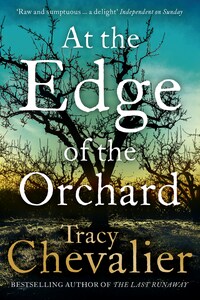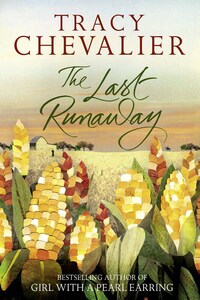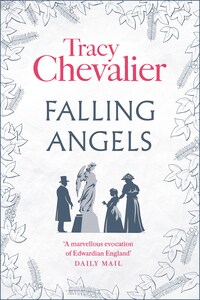The Borough Press
An imprint of HarperCollinsPublishers
1 London Bridge Street
London SE1 9GF
www.harpercollins.co.uk
First published in Great Britain by
HarperCollinsPublishers 2016
Copyright © Tracy Chevalier 2016
Tracy Chevalier asserts the moral right to be identified as the author of this work
Cover layout design © HarperCollinsPublishers Ltd 2015
Cover photographs © Gary Telford/Alamy (trees); Shutterstock.com (sky)
Apple leaves illustrations from ‘Botanical – Black and White – Tree sketches 1’, under a Creative Commons Attribution-Share Alike 3.0 Unported licence (CC BY-NC 3.0) http://vintageprintable.com/botanical-low-color/botanical-low-color-2/#jp-carousel-38965; U.S. Department of Agriculture Pomological Watercolor Collection, Rare and Special Collections, National Agricultural Library, Beltsville, MD 20705 (apple leaves).
Sequoia cone illustration from ‘Kunstformen de Natur’, 1889 (colour litho), by Ernst Haeckel (19th century, after) © Private Collection / Prismatic Pictures / Bridgeman Images.
Map © John Gilkes 2016
A catalogue record for this book is available from the British Library
This novel is entirely a work of fiction. The names, characters and incidents portrayed in it, while at times based on historical figures, are the work of the author’s imagination. Any resemblance to actual persons, living or dead, events or localities is entirely coincidental.
All rights reserved under International and Pan-American Copyright Conventions. By payment of the required fees, you have been granted the non-exclusive, non-transferable right to access and read the text of this e-book on-screen. No part of this text may be reproduced, transmitted, down-loaded, decompiled, reverse engineered, or stored in or introduced into any information storage and retrieval system, in any form or by any means, whether electronic or mechanical, now known or hereinafter invented, without the express written permission of HarperCollins e-books
Source ISBN: 9780007350407
Ebook Edition © November 2016 ISBN: 9780007350414
Version: 2016-12-14
For Claire and Pascale
finding their way in the world
The juice of Apples likewise, as of pippins, and pearemaines, is of very good use in Melancholicke diseases, helping to procure mirth, and to expell heavinesse.
—John Parkinson, Paradisi in Sole Paradisus Terrestris, 1629
To the spirit bowed with affliction, or harrowed with cares, a pilgrimage to these shadowy shrines affords most soothing consolation. Behold the evergreen summits of trees that have withstood the storms of more than three thousand years! … While lost in wonder and admiration, the turmoil of earthly strife seems to vanish.
—Edward Vischer, The Mammoth Tree Grove, Calaveras County, California, 1862
Go West, young man, and grow up with the country.
—John Babsone Lane Soule, 1851 and Horace Greeley, 1865
Contents
Cover
Title Page
Copyright
Dedication
Epigraph
Map
Black Swamp, Ohio: Spring 1838
America: 1840–1856
California: 1853–1856
Black Swamp, Ohio: Fall 1838
Black Swamp, Ohio: 1844–1856
California: 1856
Acknowledgments
Author’s Note
About the Author
Also by Tracy Chevalier
About the Publisher
THEY WERE FIGHTING OVER apples again. He wanted to grow more eaters, to eat; she wanted spitters, to drink. It was an argument rehearsed so often that by now they both played their parts perfectly, their words flowing smooth and monotonous around each other since they had heard them enough times not to have to listen anymore.
What made the fight between sweet and sour different this time was not that James Goodenough was tired; he was always tired. It wore a man down, carving out a life from the Black Swamp. It was not that Sadie Goodenough was hung over; she was often hung over. The difference was that John Chapman had been with them the night before. Of all the Goodenoughs, only Sadie stayed up and listened to him talk late into the night, occasionally throwing pinecones onto the fire to make it flare. The spark in his eyes and belly and God knows where else had leapt over to her like a flame finding its true path from one curled wood shaving to another. She was always happier, sassier and surer of herself after John Chapman visited.
Tired as he was, James could not sleep while John Chapman’s voice drilled through the cabin with the persistence of a swamp mosquito. He might have managed if he had joined his children up in the attic, but he did not want to leave the bed across the room from the hearth like an open invitation. After twenty years together, he no longer lusted after Sadie as he once had, particularly since applejack had brought out her vicious side. But when John Chapman came to see the Goodenoughs, James found himself noting the heft of her breasts beneath her threadbare blue dress, and the surprise of her waist, thicker but still intact after ten children. He did not know if John Chapman noticed such things as well—for a man in his sixties, he was still lean and vigorous, despite the iron gray in his unkempt hair. James did not want to find out.














